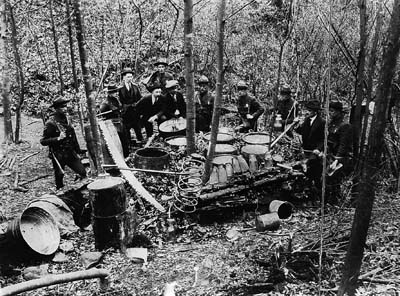The Revenooers
Enforcing Prohibition in West Virginia
By Merle T. Cole

State prohibition agents and state police raid a still at an undisclosed location in the woods of West Virginia in the 1920s. Courtesy of the West Virginia State Police Archives.
Temperance, broadly speaking, is the practice of avoiding alcohol. It can range from partial to complete abstinence. As a personal practice, some find it admirable to a point, while others believe it’s wrong foranyone to imbibe. This latter group of activists actually succeeded in making the sale or consumption of alcohol illegal in West Virginia for 18 years.
Prohibition came to West Virginia before it went national. In November 1912, voters ratified an amendment to the state constitution. Of 237,548 votes cast, 69.4 percent favored the amendment. Only three counties voted against it: Hardy, McDowell, and Ohio. The legislature passed an enforcement act proposed by Delegate Ellis Yost of Monongalia County. The amendment and the “Yost Law” both became effective on July 1, 1914. Thus, West Virginia went “dry” almost six years before the nation did.
The Yost Law gave state Tax Commissioner Fred O. Blue an extra hat to wear as state prohibition commissioner, responsible for enforcing prohibition, devising regulations, issuing permits, and inspecting for compliance. The Bureau of Prohibition, under Blue, was headed by a chief deputy commissioner, initially Castella F. Rathbone, then J. Walter Bee.
Blue pushed enforcement aggressively. In 1917, he won a U.S. Supreme Court decision (Clark Distilling Co. v. Western Maryland Railway), which upheld West Virginia’s right to prohibit liquor traffic within its borders, even if the alcohol originated from a wet state. Faced with whiskey runners transporting booze into the state, Blue ordered his prohibition agents to police the borders with adjoining wet states and intercept any illegal train contraband. Predictably, the criminals began referring to his prohibition agents as “Blue Men.”
In March 1917, Walter S. Hallanan followed Blue as tax commissioner and won two key cases in the West Virginia Supreme Court. In State v. Thompson, the court overturned the actions of a justice of the peace who had suspended the sentence of a convicted self-confessed violator. In State v. Cyrus, the court awarded a writ of mandamus compelling the Wayne County sheriff to perform his prohibition duties. Sheriff H. H. Cyrus allegedly had permitted a convicted felon to live in a suite of rooms at a hotel in the county seat, drive about at will, get drunk, and commit other offenses.
Hallanan continued the fight against out-of-state whiskey runners. But he had to devote an increasing share of his meager resources to suppressing production and distribution of moonshine liquor within West Virginia. That mission came to dominate the agency’s workload, particularly after the national prohibition of alcohol went into effect in 1920.
Blue and Hallanan had complained that prohibition enforcement was unduly distracting them from their broader responsibilities as tax commissioner. Both urged that the function be split off into a separate department. That action was finally taken when the legislature created a Department of Prohibition, effective October 1, 1921. William G. Brown, educator, lawyer, and prosecuting attorney of Nicholas County, was appointed commissioner by Governor Ephraim Morgan. With one break, he served in this role until the agency was abolished in 1932.
“‘In another generation, liquor will have disappeared, not merely from our politics, but from our memories,” said Commissioner Brown. “The very words associated with it will drop out of our vocabulary, and a new race of young men and women will have grown up to whom these words will have no significance. No other people in the world have set for themselves so great and noble an undertaking.”
The state prohibition law cast a wide net. It began by defining liquor to “embrace all malt, vinous or spirituous liquors, wine, porter, ale, beer, or any other intoxicating drink, mixture or preparation of like nature. All malt or brewed drinks, whether intoxicating or not, are deemed malt liquors and all liquids, preparations and mixtures which will produce intoxication, and all beverages containing as much as one-half of one per centum of alcohol by volume shall be deemed spirituous liquors.”
A first offense for selling, keeping, storing, or soliciting the sale of liquor was a misdemeanor with a fine of $100-$500 (about $2,450-$12,200 today) and a two-to-six-month prison term. A second offense was a felony, penalized by one to five years in the state penitentiary.
You can read the rest of this article in this issue of Goldenseal, available in bookstores, libraries or direct from Goldenseal.